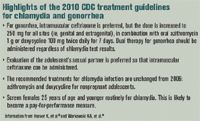An evidence-based approach to managing common sexually-transmitted infections in adolescents
Nearly 50% of sexually transmitted infections occur in adolescents and young adults between 15 and 24 years of age.

Key Points
Nearly 50% of sexually transmitted infections (STIs) occur in adolescents and young adults between 15 to 24 years of age.1,2 Sexually active adolescent women have both biologic and behavioral factors that place them at increased risk for acquiring STIs. The biologic risk factors arise largely from the ectropion, the glandular endocervical cells temporarily present on the ectocervix. This large surface area of receptors is easily colonized by sexually transmitted pathogens. In addition, adolescent women are immunologically vulnerable to the pathogens that cause STIs, including Chlamydia trachomatis and Neisseria gonorrhoeae.3
Contraception also may play a role in STI acquisition. Combination hormonal contraceptives enhance cervical ectropy, yet they are associated with a lower risk for pelvic inflammatory disease (PID). This may be because all forms of contraception containing progesterone thicken cervical mucus, which helps prevent microbes from ascending into the intrauterine cavity. The hormone-free copper intrauterine device (IUD) appears to be neutral with respect to STI and PID risk.
One of the Healthy People 2010 goals set by the US Department of Health and Human Services is to increase the number of adolescents who use both barrier and hormonal contraception4 because hormonal contraception is highly effective at preventing pregnancy but provides minimal protection against STIs. Conversely, condoms are highly effective at preventing acquisition of STIs but are slightly less effective at preventing pregnancy than hormonal methods. Right now, only about 5% of adolescent females report using both methods simultaneously.5 At least 1 study has found that use of barrier contraception by female adolescents is proportional to their perceived risk of acquiring an STI from a partner.6 Female adolescents use condoms more frequently with casual partners because they perceive a higher risk for STI acquisition.7 Only young women with a history of STIs are more likely to use condoms along with hormonal contraception.8

